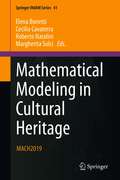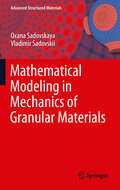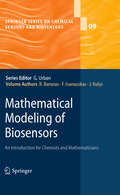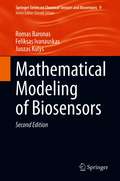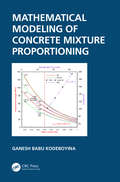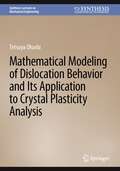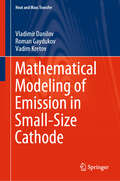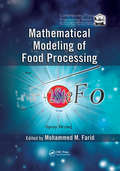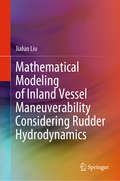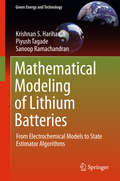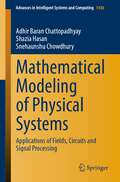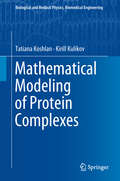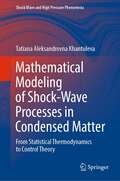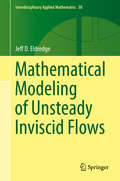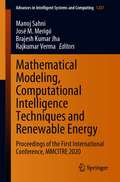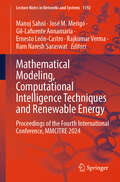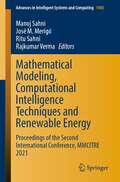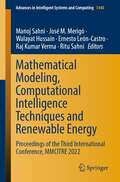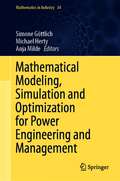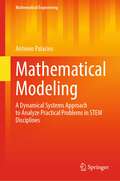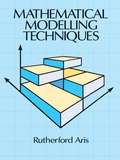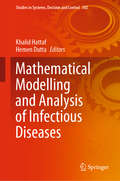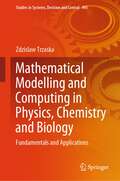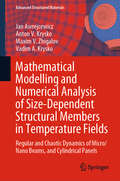- Table View
- List View
Mathematical Modeling in Cultural Heritage: MACH2019 (Springer INdAM Series #41)
by Roberto Natalini Elena Bonetti Cecilia Cavaterra Margherita SolciThis work collects the contributions presented at the INdAM Workshop “Mathematical modeling and Analysis of degradation and restoration in Cultural Heritage – MACH2019” held in Rome in March 2019. The book is focused on mathematical modeling and simulation techniques with the aim of improving the current strategies of conservation and restoration in cultural heritage, sharing different experiences and approaches. The main topics are: corrosion and sulphation of materials, damage and fractures, stress in thermomechanical systems, contact and adhesion problems, phase transitions and reaction-diffusion models, restoration techniques, additive manufacturing. The final goal is to build a permanent bridge between the experts in cultural heritage and the mathematical community. The work is addressed to experts in cultural heritage and to mathematicians.
Mathematical Modeling in Mechanics of Granular Materials
by Holm Altenbach Oxana Sadovskaya Vladimir SadovskiiThis monograph contains original results in the field of mathematical and numerical modeling of mechanical behavior of granular materials and materials with different strengths. It proposes new models helping to define zones of the strain localization. The book shows how to analyze processes of the propagation of elastic and elastic-plastic waves in loosened materials, and constructs models of mixed type, describing the flow of granular materials in the presence of quasi-static deformation zones. In a last part, the book studies a numerical realization of the models on multiprocessor computer systems. The book is intended for scientific researchers, lecturers of universities, post-graduates and senior students, who specialize in the field of the deformable materials mechanics, mathematical modeling and adjacent fields of applied and calculus mathematics.
Mathematical Modeling of Biosensors
by Juozas Kulys Romas Baronas Feliksas IvanauskasThis book presents biosensor development and modeling from both a chemical and a mathematical point of view. It contains unique modeling methods for catalytical (amperometric, potentiometer and optical) biosensors. It examines processes that occur in the sensors' layers and at their interface, and it provides analytical and numerical methods to solve enzymatic kinetic and diffusion equations. The action of single enzyme as well as polyenzyme biosensors is studied, and the modeling of biosensors that contain perforated membranes and multipart mass transport profiles is critically investigated. Furthermore, it is fully described how signals can be biochemically amplified, how cascades of enzymatic substrate conversion are triggered, and how signals are processed via a chemometric approach and artificial neuronal networks. The results of digital modeling are compared with both proximal analytical solutions and experimental data.
Mathematical Modeling of Biosensors: An Introduction For Chemists And Mathematicians (Springer Series on Chemical Sensors and Biosensors #9)
by Juozas Kulys Romas Baronas Feliksas IvanauskasThis newly designed and enlarged edition offers an up-to-date presentation of biosensor development and modeling from both a chemical and a mathematical point of view. An entire new chapter in particular is dedicated to optimal design of biosensors. Two more new chapters discuss biosensors which utilize microbial cells and are based on carbon nanotubes respectively. All the other chapters have been revised and updated. The book contains unique modeling methods for amperometric, potentiometric and optical biosensors based mainly on biocatalysts . It examines processes that occur in the sensors' layers and at their interface, and it provides analytical and numerical methods to solve equations of conjugated enzymatic (chemical) and diffusion processes. The action of single enzyme as well as polyenzyme biosensors and biosensors based on chemically modified electrodes is studied. The modeling of biosensors that contain perforated membranes and multipart mass transport profiles is critically investigated. Furthermore, it is fully described how signals can be biochemically amplified, how cascades of enzymatic substrate conversion are triggered, and how signals are processed via a chemometric approach and artificial neuronal networks. The results of digital modeling are compared with both proximal analytical solutions and experimental data.
Mathematical Modeling of Complex Reaction Systems in the Oil and Gas Industry
by Jorge Ancheyta Andrey Zagoruiko Andrey ElyshevMaster the fundamentals of reaction systems modeling for the age of decarbonization Reactor design is one of the most important parts of the oil and gas industry, with reactor processes and the accompanying technologies constantly evolving to meet industry needs. A crucial component of effective reactor design is modelling complex reaction systems, which can help predict commercial performance, shape safety procedures, and more. At a time when decarbonization and clean energy transition are among the fundamental global technological challenges, it has never been more important for engineers to grasp the cutting edge of reaction system modelling. Mathematical Modeling of Complex Reaction Systems in the Oil and Gas Industry provides a systematic introduction to this timely subject. Each chapter provides a step-by-step description of the kinetic and reactor models for a particular kind of process and its accompanying systems. Backed by voluminous experimental data and incorporating extensive simulation results, the book constitutes an indispensable contribution to the global search for clean energy solutions. Mathematical Modeling of Complex Reaction Systems in the Oil and Gas Industry readers will also find: All the required tools for developing new reactor models for different reaction scales Detailed discussion of topics including hydrocracking of heavy oils, catalyst deactivation, oxidative regeneration of catalysts, and many more Extensive treatment of both steady-state and dynamic simulations Mathematical Modeling of Complex Reaction Systems in the Oil and Gas Industry is ideal for chemical and process engineers, computational chemists and modelers, catalysis researchers, and any other researchers or professionals in petrochemical engineering and the oil and gas industry.
Mathematical Modeling of Concrete Mixture Proportioning
by Ganesh Babu KodeboyinaThe primary aim of this book is to put together an understanding of the appropriate principles of ensuring performance and sustainability of concrete. Broadly subdivided into three parts, first part contains the fundamental aspects introducing the constituent materials, the concepts of concrete mixture designs and the mathematical formulations of the various parameters involved in these designs. The second part is dedicated to discussing approaches and recommendations of American, British and European bodies related to mathematical modelling. Lastly, it discusses perceptions and prescriptions towards both the performance assessment and insurance of the resulting concrete compositions.
Mathematical Modeling of Dislocation Behavior and Its Application to Crystal Plasticity Analysis (Synthesis Lectures on Mechanical Engineering)
by Tetsuya OhashiThere are several textbooks and monographs on dislocations and the mechanical and physical properties of metals, but most of them discuss the topics in terms of more or less one-dimensional or scalar quantities. However, actual metallic materials are often three-dimensionally heterogeneous in their microstructure, and this heterogeneity has a significant impact on the macroscopic mechanical properties. With advances in computational technology, the complexity introduced by spatial heterogeneity in the microstructure of metals can now be explored using numerical methods. This book explains in simple terms the idea of extending the continuum mechanics theory of plastic deformation of crystals to three-dimensional analysis and applying it to the analysis of more realistic models of metal microstructures. This book links solid mechanics and materials science by providing clear physical pictures and mathematical models of plastic slip deformation and the accumulation of dislocations and atomic vacancies in metallic materials. Both monotonic and cyclic loading cases are considered.
Mathematical Modeling of Emission in Small-Size Cathode (Heat and Mass Transfer)
by Vladimir Danilov Roman Gaydukov Vadim KretovThis book deals with mathematical modeling, namely, it describes the mathematical model of heat transfer in a silicon cathode of small (nano) dimensions with the possibility of partial melting taken into account. This mathematical model is based on the phase field system, i.e., on a contemporary generalization of Stefan-type free boundary problems. The approach used is not purely mathematical but is based on the understanding of the solution structure (construction and study of asymptotic solutions) and computer calculations. The book presents an algorithm for numerical solution of the equations of the mathematical model including its parallel implementation. The results of numerical simulation concludes the book. The book is intended for specialists in the field of heat transfer and field emission processes and can be useful for senior students and postgraduates.
Mathematical Modeling of Food Processing
by Mohammed M. FaridWritten by international experts from industry, research centers, and academia, Mathematical Modeling of Food Processing discusses the physical and mathematical analysis of transport phenomena associated with food processing. The models presented describe many of the important physical and biological transformations that occur in food during proces
Mathematical Modeling of Inland Vessel Maneuverability Considering Rudder Hydrodynamics
by Jialun LiuThis book demonstrates that different rudder configurations have different hydrodynamic characteristics, which are influenced by the profile, the parameters, and the specific configuration. The author proposes new regression formulas to help naval architects quickly estimate the rudder-induced forces and moments in maneuvering. Furthermore, the author proposes and validates an integrated maneuvering model for both seagoing ships and inland vessels. Using the proposed regression formulas and maneuvering model, the specific impacts of rudder configurations on inland vessel maneuverability are studied. In turn, the book demonstrates the application of Reynolds-Averaged Navier–Stokes (RANS) simulations to obtain rudder hydrodynamic characteristics, and the integration of the RANS results into maneuvering models as an accurate estimation of rudder forces and moments needed to quantify the impacts of rudder configurations on ships’ maneuvering performance. In addition, the author proposes new criteria for the prediction and evaluation of inland vessel maneuverability. Simulations of ships with various rudder configurations are presented, in order to analyze the impacts of rudder configurations on ship maneuverability in different classic and proposed test maneuvers. Offering essential guidance on the effects of rudders for inland vessel maneuverability, and helping practical engineers make informed design choices, the book is of interest to researchers and academics in the field of naval engineering, as well as students of naval architecture. Industrial practitioners working on ship design may also find it beneficial.
Mathematical Modeling of Lithium Batteries
by Krishnan S. Hariharan Piyush Tagade Sanoop RamachandranCompiling state of the art approaches in mathematical modeling of lithium batteries, this monograph develops a theoretical framework of various modeling approaches, and discusses recent trends in research and their applications and limitations. It draws together the plethora of existing published research, and provides a much-needed coherent framework of battery modeling techniques. The book explores electrochemical models (EM), electrochemical impedance spectroscopy models (EIS), equivalent circuit models (ECM) and reduced order models (ROM), as well as fundamental theory, equations, model development and solution methodology to algorithms. Providing an invaluable resource to industrial R & D departments and electric vehicle manufacturers, this book is also intended for battery consortiums and academic research groups involved in battery modelling.
Mathematical Modeling of Physical Systems: Applications of Fields, Circuits and Signal Processing (Advances in Intelligent Systems and Computing #1436)
by Shazia Hasan Adhir Baran Chattopadhyay Snehaunshu ChowdhuryThe book presents mathematical modelling of physical systems by combined approach based on field theory, circuit theory and signal processing. The book is broadly divided into three parts: applications of field theory, applications of circuit theory and applications of signals processing. First part contains six chapters, second part has two chapters and third part contains two chapters. First part is further decoupled into three plus three chapters, based on the common “field nature” exhibited by electromagnetic quantities and fluid quantities.
Mathematical Modeling of Protein Complexes (Biological and Medical Physics, Biomedical Engineering)
by Kirill Kulikov Tatiana KoshlanThis book is devoted to the physical and mathematical modeling of the formation of complexes of protein molecules. The models developed show remarkable sensitivity to the amino acid sequences of proteins, which facilitates experimental studies and allows one to reduce the associated costs by reducing the number of measurements required according to the developed criteria. These models make it possible to reach a conclusion about the interactions between different amino acid chains and to identify more stable sites on proteins. The models also take the phosphorylation of amino acid residues into account. At the end of the book, the authors present possible directions of application of their physical and mathematical models in clinical medicine.
Mathematical Modeling of Shock-Wave Processes in Condensed Matter: From Statistical Thermodynamics to Control Theory (Shock Wave and High Pressure Phenomena)
by Tatiana Aleksandrovna KhantulevaThis book offers an interdisciplinary theoretical approach based on non-equilibrium statistical thermodynamics and control theory for mathematically modeling shock-induced out-of-equilibrium processes in condensed matter. The book comprises two parts. The first half of the book establishes the theoretical approach, reviewing fundamentals of non-equilibrium statistical thermodynamics and control theory of adaptive systems. The latter half applies the presented approach to a problem on shock-induced plane wave propagation in condensed matter. The result successfully reproduces the observed feature of waveform propagation in experiments, which conventional continuous mechanics cannot access. Further, the consequent stress–strain relationships derived with relaxation and inertia effect in elastic–plastic transition determines material properties in transient regimes.
Mathematical Modeling of Unsteady Inviscid Flows (Interdisciplinary Applied Mathematics #50)
by Jeff D. EldredgeThis book builds inviscid flow analysis from an undergraduate-level treatment of potential flow to the level required for research. The tools covered in this book allow the reader to develop physics-based mathematical models for a variety of flows, including attached and separated flows past wings, fins, and blades of various shapes undergoing arbitrary motions. The book covers all of the ingredients of these models: the solution of potential flows about arbitrary body shapes in two- and three-dimensional contexts, with a particular focus on conformal mapping in the plane; the decomposition of the flow into contributions from ambient vorticity and body motion; generalized edge conditions, of which the Kutta condition is a special case; and the calculation of force and moment, with extensive treatments of added mass and the influence of fluid vorticity. The book also contains an extensive primer with all of the necessary mathematical tools. The concepts are demonstrated on several example problems, both classical and modern.
Mathematical Modeling, Computational Intelligence Techniques and Renewable Energy: Proceedings of the First International Conference, MMCITRE 2020 (Advances in Intelligent Systems and Computing #1287)
by José M. Merigó Rajkumar Verma Manoj Sahni Brajesh Kumar JhaThis book presents new knowledge and recent developments in all aspects of computational techniques, mathematical modeling, energy systems, applications of fuzzy sets and intelligent computing. The book is a collection of best selected research papers presented at the International Conference on “Mathematical Modeling, Computational Intelligence Techniques and Renewable Energy,” organized by the Department of Mathematics, Pandit Deendayal Petroleum University, in association with Forum for Interdisciplinary Mathematics, Institution of Engineers (IEI) – Gujarat and Computer Society of India (CSI) – Ahmedabad. The book provides innovative works of researchers, academicians and students in the area of interdisciplinary mathematics, statistics, computational intelligence and renewable energy.
Mathematical Modeling, Computational Intelligence Techniques and Renewable Energy: Proceedings of the Fourth International Conference, MMCITRE 2024 (Lecture Notes in Networks and Systems #1192)
by José M. Merigó Rajkumar Verma Ernesto León-Castro Manoj Sahni Gil-Lafuente Annamaria Ram Naresh SaraswatThe book is a collection of best-selected research papers presented at the Fourth International Conference on “Mathematical Modeling, Computational Intelligence Techniques and Renewable Energy (MMCITRE 2024),” organized by Department of Mathematics and Statistics, Manipal University Jaipur, Jaipur, Rajasthan, India. This book presents new knowledge and recent developments in all aspects of computational techniques, mathematical modeling, energy systems, applications of fuzzy sets and intelligent computing. The book provides innovative works of researchers, academicians and students in the area of interdisciplinary mathematics, statistics, computational intelligence and renewable energy.
Mathematical Modeling, Computational Intelligence Techniques and Renewable Energy: Proceedings of the Second International Conference, MMCITRE 2021 (Advances in Intelligent Systems and Computing #1405)
by José M. Merigó Rajkumar Verma Manoj Sahni Ritu SahniThis book presents new knowledge and recent developments in all aspects of computational techniques, mathematical modeling, energy systems, and applications of fuzzy sets and intelligent computing. The book is a collection of best selected research papers presented at the Second International Conference on “Mathematical Modeling, Computational Intelligence Techniques and Renewable Energy (MMCITRE 2021),” organized by the Department of Mathematics, Pandit Deendayal Petroleum University, in association with Forum for Interdisciplinary Mathematics. The book provides innovative works of researchers, academicians, and students in the area of interdisciplinary mathematics, statistics, computational intelligence, and renewable energy.
Mathematical Modeling, Computational Intelligence Techniques and Renewable Energy: Proceedings of the Third International Conference, MMCITRE 2022 (Advances in Intelligent Systems and Computing #1440)
by José M. Merigó Ernesto León-Castro Manoj Sahni Ritu Sahni Walayat Hussain Raj Kumar VermaThe book is a collection of best selected research papers presented at the Third International Conference on “Mathematical Modeling, Computational Intelligence Techniques and Renewable Energy (MMCITRE 2022),” organized by the University of Technology Sydney, Australia, in association with the Department of Mathematics, Pandit Deendayal Energy University, India, and Forum for Interdisciplinary Mathematics. This book presents new knowledge and recent developments in all aspects of computational techniques, mathematical modeling, energy systems, applications of fuzzy sets and intelligent computing. The book provides innovative works of researchers, academicians and students in the area of interdisciplinary mathematics, statistics, computational intelligence and renewable energy.
Mathematical Modeling, Simulation and Optimization for Power Engineering and Management (Mathematics in Industry #34)
by Anja Milde Simone Göttlich Michael HertyThis edited monograph offers a summary of future mathematical methods supporting the recent energy sector transformation. It collects current contributions on innovative methods and algorithms. Advances in mathematical techniques and scientific computing methods are presented centering around economic aspects, technical realization and large-scale networks. Over twenty authors focus on the mathematical modeling of such future systems with careful analysis of desired properties and arising scales. Numerical investigations include efficient methods for the simulation of possibly large-scale interconnected energy systems and modern techniques for optimization purposes to guarantee stable and reliable future operations. The target audience comprises research scientists, researchers in the R&D field, and practitioners. Since the book highlights possible future research directions, graduate students in the field of mathematical modeling or electrical engineering may also benefit strongly.
Mathematical Modeling: A Dynamical Systems Approach to Analyze Practical Problems in STEM Disciplines (Mathematical Engineering)
by Antonio PalaciosThis book provides qualitative and quantitative methods to analyze and better understand phenomena that change in space and time. An innovative approach is to incorporate ideas and methods from dynamical systems and equivariant bifurcation theory to model, analyze and predict the behavior of mathematical models. In addition, real-life data is incorporated in the derivation of certain models. For instance, the model for a fluxgate magnetometer includes experiments in support of the model. The book is intended for interdisciplinary scientists in STEM fields, who might be interested in learning the skills to derive a mathematical representation for explaining the evolution of a real system. Overall, the book could be adapted in undergraduate- and postgraduate-level courses, with students from various STEM fields, including: mathematics, physics, engineering and biology.
Mathematical Modelling Techniques (Dover Books on Computer Science)
by Rutherford Aris"Engaging, elegantly written." -- Applied Mathematical ModellingMathematical modelling is a highly useful methodology designed to enable mathematicians, physicists and other scientists to formulate equations from a given nonmathematical situation. In this elegantly written volume, a distinguished theoretical chemist and engineer sets down helpful rules not only for setting up models but also for solving the mathematical problems they pose and for evaluating models.The author begins with a discussion of the term "model," followed by clearly presented examples of the different types of models (finite, statistical, stochastic, etc.). He then goes on to discuss the formulation of a model and how to manipulate it into its most responsive form. Along the way Dr. Aris develops a delightful list of useful maxims for would-be modellers. In the final chapter he deals not only with the empirical validation of models but also with the comparison of models among themselves, as well as with the extension of a model beyond its original "domain of validity."Filled with numerous examples, this book includes three appendices offering further examples treated in more detail. These concern longitudinal diffusion in a packed bed, the coated tube chromatograph with Taylor diffusion and the stirred tank reactor. Six journal articles, a useful list of references and subject and name indexes complete this indispensable, well-written guide."A most useful, readable-and stimulating-book, to be read both for pleasure and for enlightenment." -- Bulletin of the Institute of Mathematics and Its Applications
Mathematical Modelling and Analysis of Infectious Diseases (Studies in Systems, Decision and Control #302)
by Hemen Dutta Khalid HattafThis book discusses significant research and study topics related to mathematical modelling and analysis of infectious diseases. It includes several models and modelling approaches with different aims, such as identifying and analysing causes of occurrence and re-occurrence, causes of spreading, treatments and control strategies. A valuable resource for researchers, students, educators, scientists, professionals and practitioners interested in gaining insights into various aspects of infectious diseases using mathematical modelling and mathematical analysis, the book will also appeal to general readers wanting to understand the dynamics of various diseases and related issues. Key FeaturesMathematical models that describe population prevalence or incidence of infectious diseasesMathematical tools and techniques to analyse data on the incidence of infectious diseasesEarly detection and risk estimate models of infectious diseasesMathematical models that describe the transmission of infectious diseases and analyse dataDynamical analysis and control strategies for infectious diseasesStudies comparing the utility of particular models in describing infected diseases-related issues such as social, health and economic
Mathematical Modelling and Computing in Physics, Chemistry and Biology: Fundamentals and Applications (Studies in Systems, Decision and Control #495)
by Zdzislaw TrzaskaThis book keeps an eye in the direction of applications of advanced and high performance scientific computing in describing the behavior of natural and constructed systems, e.g. chaos, bifurcation, fractal, Lyapunov exponent, period doubling, Poincaré map, strange attractor etc. With the aid of powerful computers the modem theory of chaos and its geometry, the fractals, and attractors are developed. The concepts of object oriented computing are introduced early in the text and steadily expanded as one progresses through the chapters. The beginning of each chapter is of an introductory nature, followed by practical applications, the discussion of numerical results, theoretical investigations on nonlinear stability and convergence. This is the first complete introduction to process modelling and computing that fully integrates software tools — enabling professionals and students to master critical techniques hands on through computer simulations based on the popular MATLAB environment. The book offers a simple tool for all those oscillations that are travelling through the world, helping them discover its hidden beauty. Many applications as well as results of computer simulations are presented. The center of concern is set on existing as well as emerging continuous methods of investigations useful for researchers, engineers and practitioners active in many and often interdisciplinary fields, where physics, electrochemistry, biology and medicine play a key role. Coverage includes: • Dynamic behavior of nonlinear systems, • Fundamental descriptions of processes exhibiting nonlinear oscillations, • Mechanism and function of structures of nonlinear oscillations’ patterns, • Analysis of dynamical oscillations in electric circuits and systems, • Artificial intelligence models of natural systems, • Nonlinear oscillations in chemistry, biology and medicine, • Oscillations in mechanics and transport systems, • Oscillations in fractional-order systems, • Energy harvesting systems from the surrounding environment. With an insatiable appetite for exploring the surrounding world and doing research, this book can help readers quickly find ways to use new computers and facilitate the quest for greater knowledge and understanding of reality. The reach of novelty of the book ranges from new mathematical ideas to motivating questions and science issues in many subject areas.
Mathematical Modelling and Numerical Analysis of Size-Dependent Structural Members in Temperature Fields: Regular and Chaotic Dynamics of Micro/Nano Beams, and Cylindrical Panels (Advanced Structured Materials #142)
by Jan Awrejcewicz Vadim A. Krysko Maxim V. Zhigalov Anton V. KryskoThis book is devoted to researchers and teachers, as well as graduate students, undergraduates and bachelors in engineering mechanics, nano-mechanics, nanomaterials, nanostructures and applied mathematics. It presents a collection of the latest developments in the field of nonlinear (chaotic) dynamics of mass distributed-parameter nanomechanical structures, providing a rigorous and comprehensive study of modeling nonlinear phenomena. It is written in a unique pedagogical style particularly suitable for independent study and self-education. In addition, the book achieves a good balance between Western and Eastern extensive studies of the mathematical problems of nonlinear vibrations of structural members.
